-
Posts
5,412 -
Joined
-
Last visited
-
Days Won
15
Posts posted by LongLeftFlank
-
-
Think the question about general building protection and resistance levels has already been answered by enough testing:
1. Independent = light to very light (barns)
2. modular = medium to heavy
3. cathedral = heavy
The "light" category does not quite work for a european setting, but is more probably ported over from CMSF middle east. Also yet might work for russia and parts of eastern europe.
Particularly disappointing is the quick dropping of indi buildings, without showing intermediate damage levels. It´s simply wrong and crappy looking.
Another issue is the quick rubbling of "walls" (low, high, stone, brick) by single 80mm mortar hits or near hits. Observed the same for 4.2" smoke rounds. How is that assumed to happen? That definitely needs some readjusting in the game. Me guesses there´s still some CMSF code involved.
1. I didn't bother to bombard the barns, but I notice no difference in durability between the Modular and Independent House or Commercial building types. They take between 8-12 105mm medium arty hits to rubble.
2. Not sure what you're saying -- Intermediate damage starts showing up on the intermediate buildings almost at once -- pockmarks, leading to blown out walls
3. Agree on the perimeter walls behaving more like Third World cinderblock than solid stone or brick. Sound like it too (that hollow sound they make).
Slysniper, note that the variety of independent building (and maybe other terrain) types you use on a given map seems to matter for memory and load time purposes nearly as much as the number of buildings. My little test map was dead flat and contained 3 units yet took several minutes to load at the 43% mark owing to the fact that I had one of each type of Inependent House and Commercial building on there. Once the scenario loaded, it behaved OK though (not laggy).
-
Not bloody likely. Libya has oil and a rebellion that can actually carry a lot of its own ground fight, yet Gaddafi is still there.
The Turkish army is conscripted -- sending body bags home from "war of choice" would play even less well than it does in our volunteer (i.e. you signed up for it) armies. The public gets really upset when the Kurdish PKK blows up a truckload of Turkish draftees now and then.
On the other hand, they might be willing to host and participate in a NATO intervention. But I doubt they would go in themselves as the lead ground force, even with Allied airpower and airlift backing them.
-
If you bombard the top floors of a multistory building, it will occasionally (1 in 10 about) collapse but leave a gutted shell of the ground floor standing (albeit damaged). Regrettably, this does not seem to apply to single story buildings, including that little church.
As I've noted before, pre-20th century buildings relied on (thick) outer walls as primary load bearing elements. Stout wooden beams hold up the floors and roof but don't hold the structure itself together (unlike modern construction). So even in a structure gutted by fire, the outer walls would tend to remain standing in the absence of a kinetic force knocking them over.
-
Conclusion from my tests above: the only building type in CMBN that is more resistant than normal to artillery fire is the Cathedral type (though not the little one-story church -- that falls down as easily as the rest, which is disappointing).
So it looks like if I want to represent the heavily fortified chateau (Gestapo HQ) of St Gilles (which according to the histories proved largely impervious to artillery and had to be riddled point blank with 76mm tank destroyer fire followed by demo charges to finish the defenders) I am stuck with using the 3 story Cathedral tile. Pity, that.
I decided to rerun my 105mm battering test with some poor German FO teams hunkered down -- 3 guys on each floor Hiding.
The first 2 rounds took out 2 of the men on the top floor. The third rapidly decamped to the ground floor (and then wisely decided to hide behind the structure -- he was the sole survivor). The ground floor team was rapidly pinned and Rattled, and after the perimeter stone wall was demolished, exposing the ground floor to Target by the Priests, was eventually killed off after about 50 rounds came in (15 minutes of nonstop shooting by two M7s). As in the prior test, the building showed pockmarks but no significant structural damage. Overall, a satisfying representation of a fortified building.

-
BTW, the Germans used 81mm mortars, right? I think they are sufficiently powerful to do considerable damage to these ancient structures. Thus the need for 'artillery or armour support' when assaulting these structures. I'm not so sure that the US 60mm mortar was quite so effective but I'm certainly no expert and am very happy to be corrected (politely, of course). We'll just have to wait and see how effective the Brit 2" mortar is against troops in buildings.
First, I happen to believe that the destructive blast effects of garden variety mortar rounds, which were designed to impact on the surface and to maximize fragmentation for antipersonnel purposes rather than plowing into and then blowing up the earth and its contents like artillery shells, are overmodeled in the game (my case is supported by the existence of specialized "demolition" rounds which presumably have a special fuze and thicker casing to delay and channel the blast). But let's let that pass for the moment.
"Damage" also comes in different varieties. As you've said, castle walls were thick, extremely thick, designed to defy the power of rams, pickaxes and catapults. These would also create formidable cover against flat trajectory bullets and shells, agreed, although lengthy bombardment would eventually create breaches (gunpowder is one reason the feudal period came to an end in the 15th century. Also, I believe that most of the obsolete castles were either converted into manor homes or pulled down for quarry, so one per village is probably overstating).
But the roofs would be a different matter -- most likely slates covering a framework of sturdy oak beams. And then there would be oak floors and beams below, assuming multiple stories.
Mortar rounds, as mentioned, would mainly impact on the roof and not penetrate, at least until sufficient slates were smashed to create gaping holes to drop through. And then you'd have to repeat the process on the upper floors. Plunging shells of sufficient calibre though would frequently punch through to explode in the interior.
FWIW
-
...And no joie in Ville de Boue. All 16 independent House types and all 8 Commercial types were totally demolished by between 8 and 12 x 105mm rounds each. No evident variation in survivability.
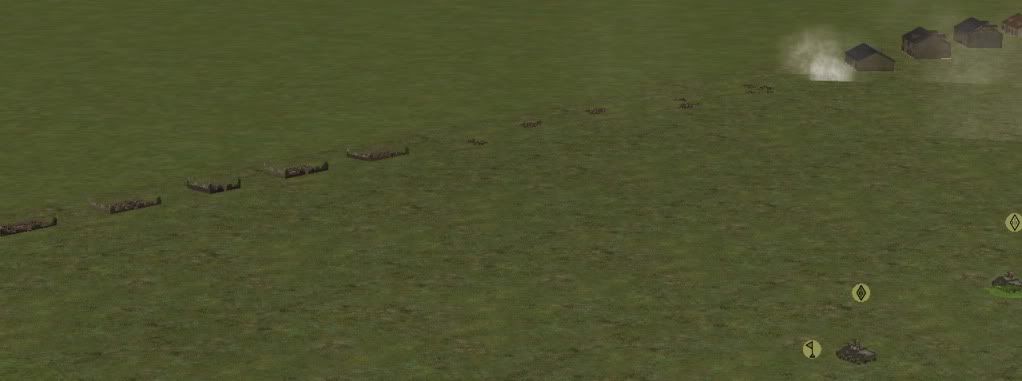
-
In a previous thread, I proved out the resiliency of the large cathedral segments (the 3 story and the 8 story) by bombarding them with 105mm until the Priest ran out of ammo... they took superficial damage only (although the little 1 story village church collapsed rapidly -- very disappointing!)
I have now resumed testing with a "chateau" cobbled together from the second 2 story independent house on the pallette, which looks sturdy enough, together with 2x3 story modular buildings on the corner.
No joy however: both building types took 8-12 105mm rounds each to demolish. Back to the shootin' range to find a house that holds up.

-
I'd love to see the M43 available to the infantry as well. Perhaps something could be done using the default wireframe for the peaked officers cap since it's undersized for the heads and looks silly anyway.
Vein swapped in the tank commanders cap which looks better.
-
That should be just about when the CM2+ Russian Front Consolidated 41-45 Massive Multiplayer edition will be able to be downloaded to my goggle-enhanced-to-give-a-360-degree-view-of-the-steppes rig, which will be 2000 faster than the one I have now. The Brain-wave control activated version will not quite be ready...
Just one catch. You must think.... in Russian.
-
Awesome weathering -- one of the best AFV mods I've seen in any CM product! One nit: tracks look far too clean.
-
If memory serves, Steve said they removed it since pretty much nobody was using it for scenarios they published.
-
Great thread here -- useful info for a CMBN "fortification how to manual"' Inspiring me to do some testing once I get home.
-
I know I've made some very poor decisions recently, but I can give you my complete assurance that my work will be back to normal. I've still got the greatest enthusiasm and confidence in the mission. And I want to help you.
LOL! +9000!
-
Also, if mappers build forests properly (see some of the how-to posts from last week on another thread), they should have intermediary bands of thickets and bushes and smaller trees along the perimeter, along with even some gapped hedge tiles. This makes a forest that offers more realistic concealment, blocking LOS better, and offering realistic ambush possibilities. Too many forests on existing maps lack this detail and are too easy to see into/see through.
Amen. Relevant thread is here
-
As I was recently poring over that well known Green Book detailed map of the Nazi defenses around Le Carillon, I noticed that while the Germans set up CPs in various farmhouses, they aren't shown as containing defensive positions... MGs are set up next to them or keyholed between them. The Germans seem to have preferred digging into the nearby bocage to strongpointing the buildings.
I suppose that makes sense -- they're magnets for enemy fire, especially artillery and while you can certainly reinforce the ground level walls with stacks of sandbags shoring up the roof is another matter. And since these houses were generally inside walled/hedged enclosures, the fields of fire could be restricted as well. That doesn't mean they weren't commonly used as firing or sniping positions in the actual fights (and also booby trapped) but I found the lack of marked fortification interesting.
On the other hand, I do know for a fact that further north the Germans fortified a whole bunch of sturdy stone buildings along RN-3 ("Hell's Highway") including shops, a church and chateau at St Gilles -- not just sandbagging the walls, windows and cellars but adding poured cement bomb shelters and slit trenches as well.
The Yanks basically had to silence them using demo charges and point blank tank/TD direct fire. The 2 day fight for these positions more or less devoured 2 companies of the US 137th Infantry (including the regimental commander) and only 3 German prisoners were taken. Grim stats.
-
My biggest kvetch with the AI other than the absence of event triggers is that units in the same AI group (and there are only 8 of these available) randomly pick their next objective square from those painted in the Order, even if it means a high risk lateral move across the enemy front. This makes advancing in a skirmish line on a broad front, for example, basically impossible unless you have the group converge on a narrow objective area.
In CMSF, my workaround was to use a "jellyfish" model of movement where the AI group would move to a dispersed set of objectives then to a tightly clustered set (preferably out of likely enemy view), then out again, etc. No idea yet if that'll work in CMBN.
FWIW
-
I too am getting OOM and crash when I try to preview this map. Locks out at 43%
-
Thanks Broadsword. The major road net is now complete and I'm starting to lay out the footprints of the settlements. Screenies will follow as available.
This building from the Le Carillon settlement looks just a wee tad different than most of the buildings appearing on CMBN maps. Getting these hamlets and farmsteads looking good is what is going to absorb most of my time from here on in. Until I can persuade the wife to spend a holiday out there so I can trek around photographing various buildings, are there any French gamers willing to collaborate on that?

-
Those urban cathedral buildings, including the spires, are very resilient against HE too (much more so than the small rural churches). I've yet to see one fully rubbled.
-
One could also use low or high bocage (with gaps) in place of the hedges. But both that and creating an embankment would provide a lot more solid cover to units in the thicket than they would really have sitting in a stand of saplings and tall bushes.
-
The exact tiles and contents are described in detail in the lower paragraphs of post 4 above. I can do a screenie if you still want it, but it won't show you more than I described there. Everything else is flat grass etc.
EDIT: I just emailed you the file.
-
So enough with the eye candy..... does adding a "thicket" have a meaningful effect on LOS?
To test this, I removed the thicket (the bushes and hedges, although I left the light forest undergrowth in place) from the front layer (Tile 4) on the left side (of the screenie), then had my StuH try to find the "deepest in" Area Target it could on each side.
With the thicket, the farthest in the StuH could trace a valid LOS and land a shot is about 145m (3 tiles in). This was a singularity; LOS was mostly blocked from about 137-139m.
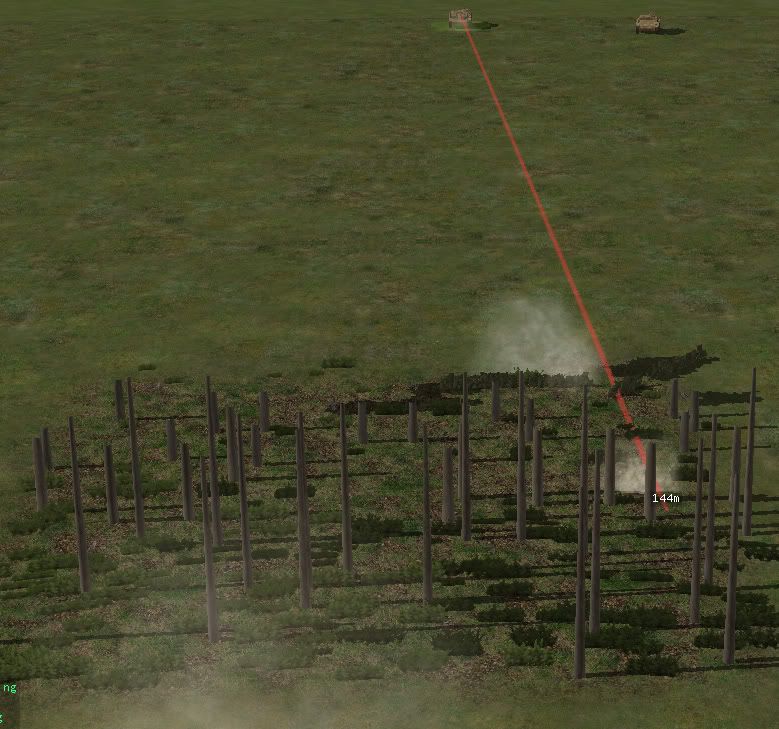
Without the thicket, the farthest in the StuH could trace a valid LOS (and land shot) was 160m (4 tiles in). This was also a singularity, as LOS was mostly blocked from about 140-145m.
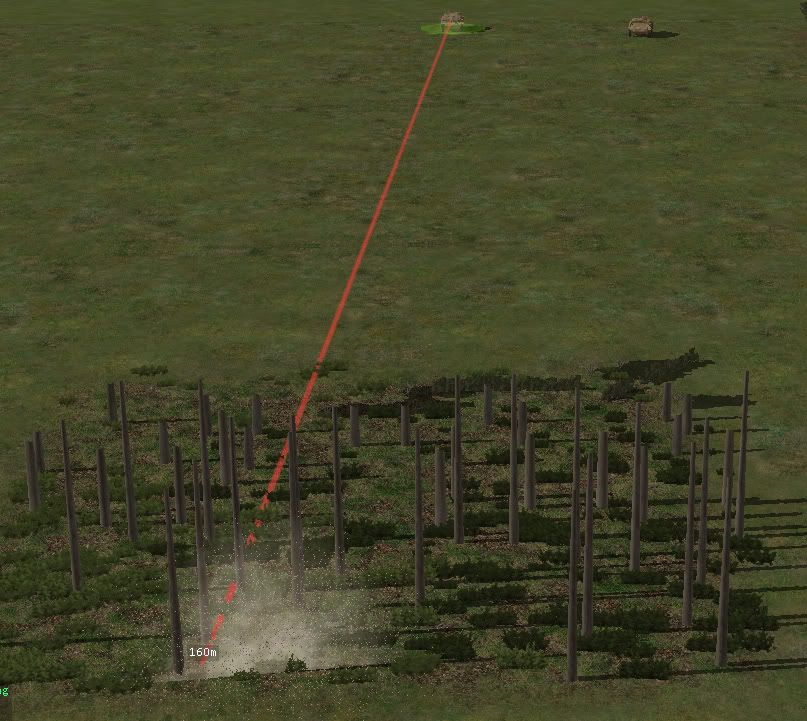
In both cases, the StuH put most of its shots near the target spot, although one occasionally fell short.
I call this test inconclusive, but it suggests to me that a tall "screening" thicket or stand of saplings is needed. I haven't done live fire spotting tests (yet), but units shouldn't be able to spot so deeply into (or out of) the interior of most deciduous forests in summer.
-
Since the OP seems to have been answered, I think I'll hijack this thread and expand it to a "Foliage and Concealment" discussion. Apologies in advance to Georgie.
As I work with the Editor (yes, I'm working on my La Meauffe-Le Carillon monster map again after a long absence), I continue to believe that the most critical terrain tile that remains absent is a "thicket", which is to say a dense stand of young trees, tall bushes and shrubbery (*nee!*) that, at least in summertime:
(a) is useless from a cover standpoint, and
(
 creates little hindrance to infantry or vehicle movement, BUT
creates little hindrance to infantry or vehicle movement, BUT© provides excellent concealment to both men and vehicles and -- most important --
(d) is tall enough to largely mask the interior of a forest or wooded area from the adjacent open ground (field, road) for spotting purposes, and vice versa
At present, the deciduous woodlands on nearly all maps look like Central Park, which is to say, some busy soul has been pruning away the new growth that would normally crowd the margin between forest shade and (sunny) open ground. In reality, that labour is only undertaken in parks and orchards -- certainly not on the margin of farm fields where farmers want as full a windbreak as possible shielding their crops and pastures. In a combat situation, a lot of cleared underbrush should be a dead giveaway that someone has created a field of fire for his weapons.
Thickets are very important tactically, as they effectively (~90% in summer) separate units in forests visually from units outside them, even when they are in quite close proximity. They are also tall enough to hide AFVs (ever wonder why those StuGs in period photos are all covered with brush? -- btw it would be super cool to get a underbrush "over-skin" layer for StuGs and PzIVs analogous to the Stryker "slat cage" in CMSF, with no game effects)
Pine or mixed forests are a little different -- thickets are still present on the margin but they tend to present more gaps into the interior, but that isn't what we are mainly dealing with in Normandy.
Anyway, rather than (only) whine and plead for a new terrain tile, I figured I'd play around a little to see if I could approximate a reasonably dense forest margin using the tools available. The following is what I came up with, with a couple of StuGs sitting in ambush for colour:
Head-on view (5 8x8m tiles across)
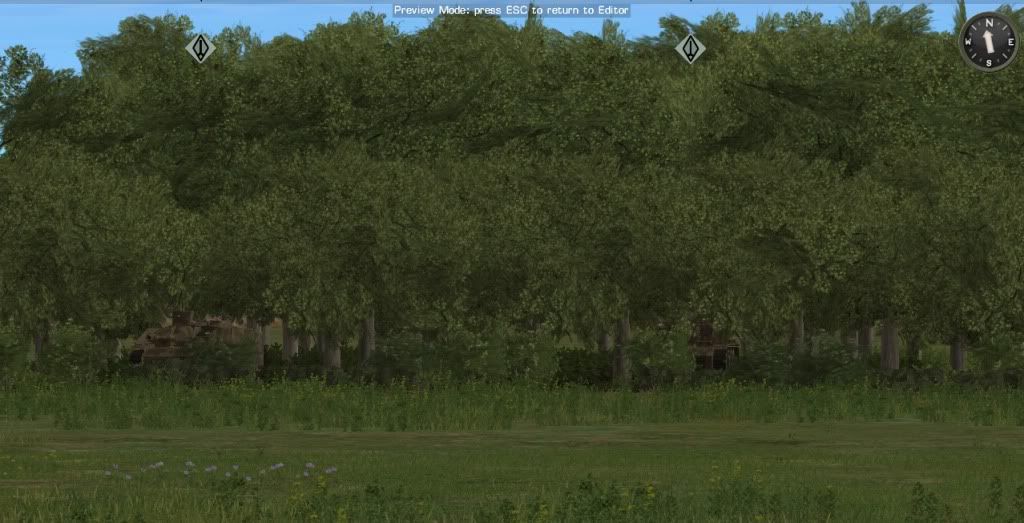
Side (cutaway) view:
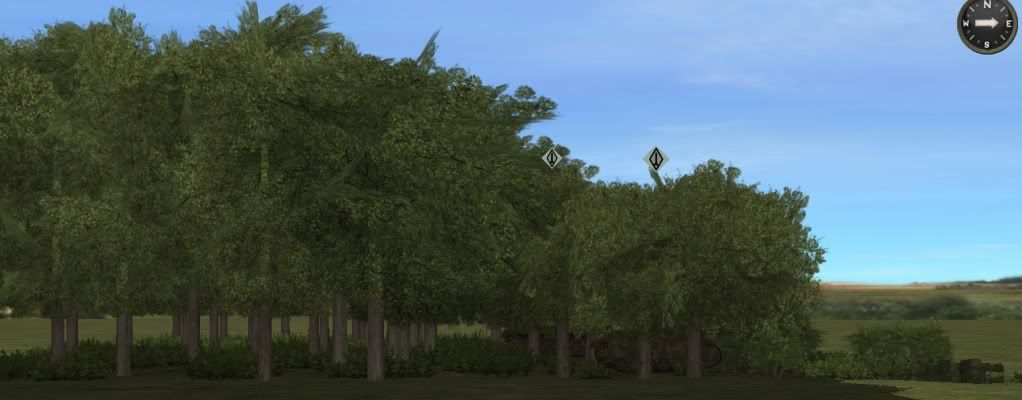
From left to right, here is the terrain I used:
Tiles 1 and 2: Big deciduous trees (type A and C) alternating x3 and x2, with "heavy forest" undergrowth (I don't want tanks going back there)
Tile 3: Small deciduous trees (orchard type D) x 3, with "light forest"
Tile 4: My ersatz thicket, which is a combination of:
(a) the tallest bushes type C x 3
(
 "gapped" hedge tiles alternating between diagonal and straight-across angles so as to look random and not man-made.
"gapped" hedge tiles alternating between diagonal and straight-across angles so as to look random and not man-made.© "light forest" undergrowth.
Tile 5. Weeds or tall grass.
I also tried adding "brush" to the thicket, but it looks like a straight carryover from CMSF desert scrub and doesn't seem to provide much incremental concealment, at least visually. But if there's a game advantage, perhaps it should be added -- let me know SVP.
-
I have friend that runs a Japanese antique business in SF.
You and your friend have read "The Man in the High Castle" by Philip K Dick, right?



testing on building protection
in Combat Mission Battle for Normandy
Posted
Yes, a little project involving about 2000 walled building compounds called Ramadi ;-)
The prophylactic wall simply delays the reckoning by soaking up the damage that would otherwise weaken the ground level. Once it falls (2-3 hits of any calibre or near misses of larger calibre) the benefit ends. Simple enough.